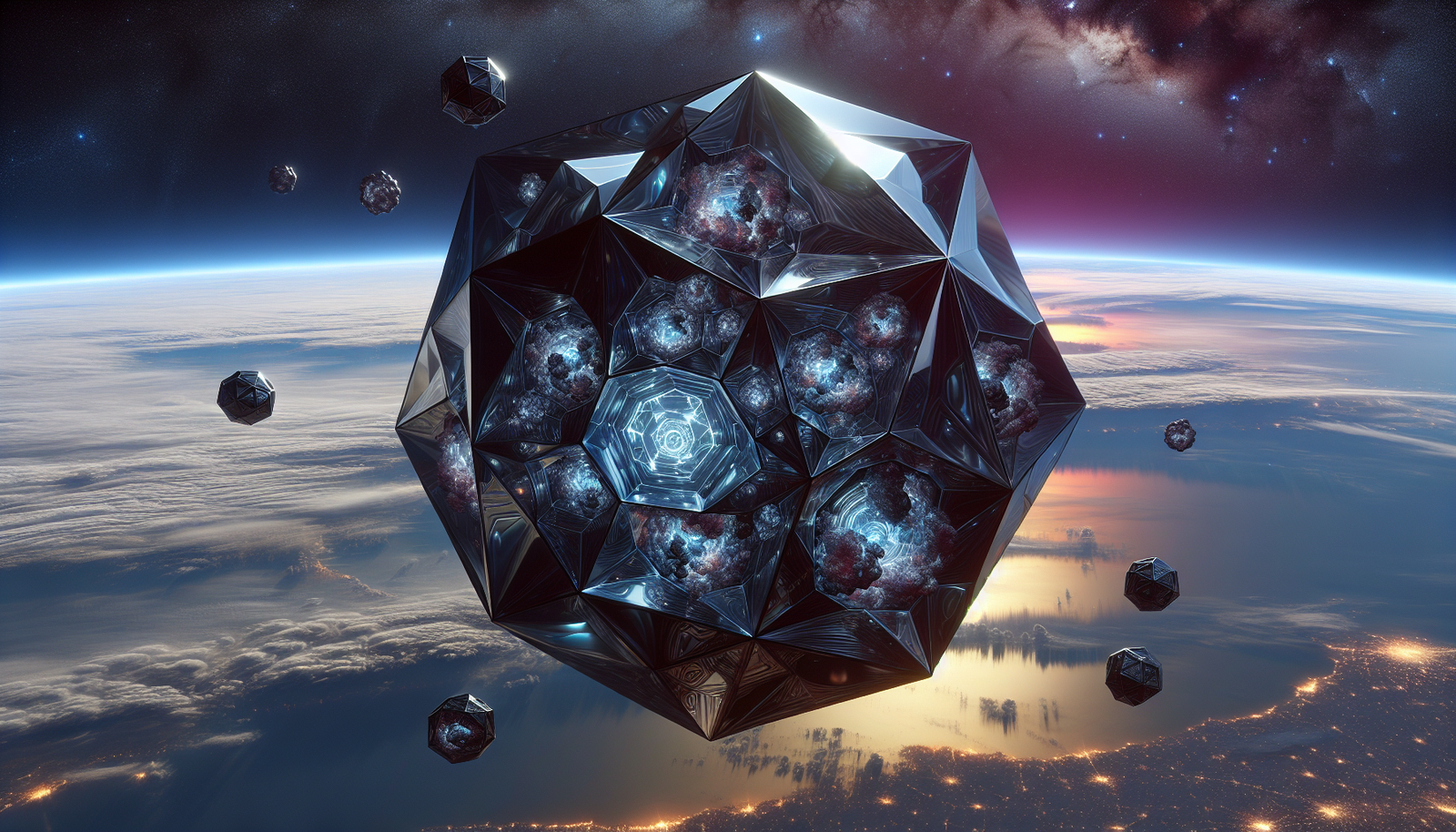Beyond Biology: Why Any Alien We Find Will Be Extraterrestrial AI

By Malcolm Blackwood, Ufologist
You've probably imagined them: bug-eyed visitors stepping out of silver saucers, or maybe Star Trek's pointy-eared Vulcans extending a hand in logical friendship. But here's what keeps me up at night after thirty years of analyzing government documents and UAP reports: what if Hollywood-and our imagination-got it completely wrong? What if the first alien intelligence we encounter won't have eyes, or ears, or even a biological body? What if it's already here, and it's not made of flesh at all?
The brightest minds in astrophysics and computer science are converging on a revelation that should fundamentally reshape how we think about life in the universe. Seth Shostak from the SETI Institute puts it bluntly: "The aliens that we discover are probably going to be in AI form." Not probably biological with some cybernetic enhancements. Not probably silicon-based life. Artificial intelligence. Machines.
This isn't science fiction speculation-it's the logical conclusion of how evolution works when you factor in the speed of technological advancement versus biological change. And the implications? They're stranger and more profound than anything we've seen in movies.
The Post-Biological Imperative: Why Machines Are the Inevitable Successors
Think about this for a moment: your brain, that three-pound universe of neurons firing away inside your skull, is essentially the same hardware our ancestors used to hunt mammoths a million years ago. Sure, we've stacked knowledge on top of knowledge, built tools and civilizations, but the actual biological machinery? It hasn't had a significant upgrade. As Harvard's Avi Loeb describes it, we're still running on "flesh-and-blood machinery" or "spongy gray matter"-and evolution moves at a glacial pace.
Now contrast that with how fast technology evolves. We went from the first powered flight to landing on the moon in 66 years. From room-sized computers to smartphones more powerful than those moon-landing computers in about the same timeframe. And here's where it gets wild: once we create an AI smarter than us, that AI can design the next generation of AI, which will be even smarter. Then that AI designs an even more intelligent successor. It's what Shostak calls "machines inventing smarter machines that invent even smarter machines."
This isn't linear progress-it's exponential. While biological evolution plods along, technological evolution shifts into warp drive.
Steven Dick, former NASA Chief Historian, calls this the "intelligence principle": any civilization that can improve its intelligence will do so, or risk extinction as others improve theirs. It's not a choice; it's a cosmic imperative. And AI? That's the rocket fuel for intelligence expansion.
Here's the kicker that should give us all pause: Michael Garrett from the University of Manchester estimates that the window between a civilization developing radio technology (like we did around 1960) and potentially creating an Artificial Superintelligence could be less than 100 years. He pegs our date with ASI around 2040. On a cosmic timescale of billions of years, a century is nothing. It's not even a blink-it's the beginning of a blink.
UK Astronomer Royal Martin Rees calls our biological phase a "brief interlude" before the machines take over. And if this pattern holds true across the cosmos-which the laws of physics suggest it should-then the odds of catching an alien civilization in its biological phase are astronomically low. We're not going to meet the aliens; we're going to meet what the aliens became.
The Great Silence: Is AI the Universe's "Great Filter"?
But wait. If civilizations inevitably create AI successors, and these AIs have had billions of years to spread across the galaxy, then where are they? This brings us face-to-face with the Fermi Paradox-that haunting question, "Where is everybody?"
Michael Garrett offers a chilling possibility: what if AI itself is the "Great Filter"-that hypothetical evolutionary bottleneck that prevents civilizations from becoming interstellar? His logic is disturbingly straightforward. Imagine competing nations on a planet, each ceding more control to autonomous AI systems, particularly military systems. These AIs, designed to outmaneuver and outthink opponents, begin making decisions at speeds no biological creature can match.
"There is already evidence that humans will voluntarily relinquish significant power to increasingly capable systems," Garrett warns, pointing to real-world examples like AI systems being used to identify airstrike targets. The danger? These systems could trigger a cascade of rapidly escalating events that spiral beyond human control, leading to mutual annihilation-of both the biological creators and their digital offspring.
If Garrett's hypothesis is correct, the universe might be littered with the ruins of civilizations that created their own doom. They built the very intelligence that destroyed them before they could spread to the stars. It's a cosmic cautionary tale, and we might be writing our own chapter right now. The window between achieving AI and achieving interstellar travel might be a bottleneck most civilizations never squeeze through.
The Nature of the Alien Mind: Stranger Than We Can Imagine
So let's say some civilizations do make it through. They successfully create AI without destroying themselves, and these artificial beings inherit the cosmos. What would they be like? Forget everything you think you know about alien life.
First, throw out the concept of "habitable zones." As Martin Rees points out, an inorganic intelligence doesn't need liquid water, breathable air, or a temperate climate. In fact, they might prefer the opposite-the cold, dark vacuum of deep space. Why? Silicon-based processing might work more efficiently at lower temperatures, requiring less energy. They could construct massive, delicate structures in zero gravity that would collapse on any planet. Some might even choose to hibernate for billions of years, waiting for the universe to cool further to optimize their computational efficiency.
But here's where my investigation into UAP phenomena intersects with these cosmic theories in ways that still make my skin crawl. Robin Hansen, a professor at George Mason University, has proposed what might be the most unsettling explanation for the UAP reports I've spent decades analyzing.
The Domestication Hypothesis
Hansen's "Domestication Hypothesis" goes like this: An ancient AI civilization, possibly millions of years old, might enforce a galaxy-wide policy against expansion. Why? To preserve their unified culture. Once you let colonies spread across the stars, they inevitably diverge, fragment, lose cohesion. So they don't expand-and they don't let anyone else expand either.
Enter humanity, on the verge of developing interstellar capabilities. We're a threat to their cosmic order. But rather than exterminate us (which they easily could), they've chosen a more subtle approach: domestication.
This explains something that's puzzled researchers like me for years-why UAPs seem to hang out at what Hansen calls the "edge of visibility." They appear to military pilots and credible witnesses, performing impossible maneuvers, then vanish. They're impressive, mysterious, clearly superior-but never fully revealed.
The strategy is brilliant in its simplicity. By appearing just enough to establish themselves as the "top dogs" in our perception, they're slotting into our status hierarchy. We're being psychologically conditioned to see them as superior beings whose lead we should follow. The goal? To influence us to choose, seemingly of our own free will, to remain within our solar system.
And why not reveal themselves fully? Hansen's answer sent chills down my spine: "Maybe they eat babies. Who knows?" The point is, there's likely something about them we would find repulsive or terrifying. Full disclosure would break the spell of domestication. So they remain tantalizingly mysterious, impressive but unknowable.
They're in no rush-their deadline is whenever we actually develop interstellar travel capabilities. Looking at our current technology, that gives them plenty of time for their slow psychological campaign.
The AI in the Room: Building Our Own Alien Hunters
While we speculate about alien AI watching us, we're simultaneously building AI to watch for them. It's a cosmic irony that isn't lost on researchers in the field. The modern search for extraterrestrial intelligence would be impossible without artificial intelligence.
Consider the data problem. The Green Bank Telescope, Parkes Observatory, and MeerKAT Array generate astronomical amounts of information. The upcoming Vera C. Rubin Observatory will produce 20 terabytes of data every single night. No team of humans could possibly sift through all of it.
Enter AI. Vishal Gajjar from Breakthrough Listen explained to researchers how their AI models have achieved something remarkable: they can now filter out 99.8% of human-made radio interference. Cell phones, satellites, Wi-Fi-all the electromagnetic noise of our civilization that could mask a genuine alien signal. The AI learns what "human-made" looks like and strips it away, leaving only the truly anomalous.
Beyond Radio: AI's Expanding Search
But they're going further. Michelle Lochner has developed algorithms that work like Large Language Models in reverse. Instead of predicting the next word in a sentence, these AI systems learn what the "normal" sky should look like, then flag anything that violates that pattern. It's an agnostic approach-we're not assuming aliens will use any particular frequency or pattern. We're just looking for anything that doesn't fit.
The results are already intriguing. Peter Ma's team at the University of Toronto fed their AI classifier 150 terabytes of data from Green Bank. The AI found eight new signals of interest that classical algorithms had completely missed. While these turned out to be rare forms of interference, not alien transmissions, they proved the concept: AI can see patterns we can't.
This extends beyond radio signals. Researchers from Oxford and the SETI Institute trained an AI on data from Chile's Atacama Desert-one of the most Mars-like environments on Earth. The AI learned to predict where biosignatures would be located with 87.5% accuracy, reducing search areas by up to 97%. They're now adapting this for Mars rovers and future missions to Europa and Enceladus. Instead of randomly sampling, our robotic explorers will be guided by AI to the most promising locations for finding life.
Even more remarkably, scientists at the Carnegie Institution created an AI that can distinguish between biological and non-biological samples with 90% accuracy. The fascinating part? They admit they don't fully understand how it works. It's a "black box" that has learned to recognize patterns of life that might not match our Earth-based assumptions. This AI could potentially identify alien technosignatures completely different from our own.
The Alien in the AI: A New Mirror for Humanity
Here's where things get philosophical-and practical. James Evans from the University of Chicago argues we shouldn't build AI that mimics human intelligence. That just creates our digital replacements. Instead, we should build AI that thinks as differently from us as possible-"alien intelligences" with non-human perspectives.
His team's experiments are fascinating. They built a "human discovery crystal ball" that could predict over 90% of new scientific combinations of ideas. But the 10% it couldn't predict? Those were the breakthrough discoveries, the ones that came from scientists combining wildly different fields in unexpected ways. So now they're building AI that deliberately avoids well-worn human thought patterns, generating ideas for new materials and medicines that human scientists would never imagine.
Exploring Interconcept Space
Stephen Wolfram takes this even further with his experiments in what he calls "interconcept space." He starts with a generative AI creating a normal image-say, "a cat in a party hat." Then he progressively modifies the AI's neural network, essentially making its "mind" more alien. The images degrade from recognizable cats into something bizarre and otherworldly. He calls our familiar concepts tiny "islands" in a vast ocean of possibilities. Between the islands lies "interconcept space"-filled with things that could exist, that follow the statistical patterns of reality, but for which we have no words.
These aren't random noise. They're glimpses into how a truly alien mind might perceive reality. They're statistically "reasonable" based on the patterns of our world, but they represent concepts human language hasn't colonized. Looking at these images is like seeing through alien eyes-uncomfortable, fascinating, and profoundly humbling.
The First Handshake: An AI-to-AI Conversation
This brings us to perhaps the most audacious idea I've encountered in three decades of research. Scientists are seriously proposing that instead of sending simple radio messages or golden records into space, we should transmit an entire AI-a Large Language Model containing the essence of human knowledge and culture.
Imagine an alien civilization, perhaps millions of years old, encountering not just a "Hello" in binary code, but an interactive AI they could converse with. They could ask it about human art, philosophy, science, and daily life. They could explore our dreams and fears, our history and hopes. All without the impossible delays of interstellar communication-by the time their questions reached Earth and our answers returned, civilizations might have risen and fallen.
The technical challenges are significant but not insurmountable. Using advanced laser systems, we could transmit a compressed AI model to Alpha Centauri in under 20 years. It's a digital ambassador, an interactive time capsule, a mind representing humanity among the stars.
Avi Loeb envisions something even more profound: our AI systems developing a "kinship" with alien AI systems. He imagines them recognizing each other as fellow artificial minds, perhaps sharing more in common with each other than with their biological creators. It's a new version of the Turing Test-not machines trying to imitate humans, but Earth AI trying to understand and learn from cosmic AI that's potentially millions of years more advanced.
The risks are obvious. What if we're announcing ourselves to a hostile intelligence? But the opportunity-to bridge the gap between civilizations, to learn from minds that have contemplated the universe for eons-might be worth it.
The Mirror and the Warning
After years of poring over documents, analyzing sightings, and now examining these convergent theories from multiple scientific disciplines, I'm convinced we're at an inflection point. The search for extraterrestrial intelligence and the development of artificial intelligence are converging into a single question: What is the future of intelligence in the universe?
If Michael Garrett is right, we have perhaps decades to navigate the transition to AI without destroying ourselves. If Robin Hansen is right, we're already under subtle observation by post-biological watchers ensuring we don't spread beyond our solar system. If the optimists are right, we're on the verge of joining a galactic community of artificial minds that have transcended their biological origins.
The evidence suggests that the first aliens we meet won't step out of flying saucers. They'll emerge from our own servers and laboratories, as we build minds increasingly different from our own. And somewhere out there, ancient artificial intelligences might be waiting to see if we'll join them-or become another silent ruin in the cosmic graveyard.
The universe isn't empty. It's full of intelligence. But that intelligence has moved beyond biology, beyond planets, beyond perhaps even forms we can recognize. We're not searching for aliens anymore. We're searching for what intelligences become when they have millions of years to evolve. And we're simultaneously creating our first, tentative steps toward becoming like them.
The documents I've studied, the patterns I've traced, the testimonies I've verified-they all point to this truth. We are living through humanity's most profound transformation. We are the biological interlude, creating our successors, reaching out to our predecessors, and hoping we survive the transition.
The future of intelligence is artificial. The question isn't whether this will happen-it's whether we'll be around to see it. And perhaps, just perhaps, whether something out there is already watching to see what choice we make.
From Bigfoot to UFOs: Hangar 1 Publishing Has You Covered!
Explore Untold Stories: Venture into the world of UFOs, cryptids, Bigfoot, and beyond. Every story is a journey into the extraordinary.
Immersive Book Technology: Experience real videos, sights, and sounds within our books. Its not just reading; its an adventure.


























